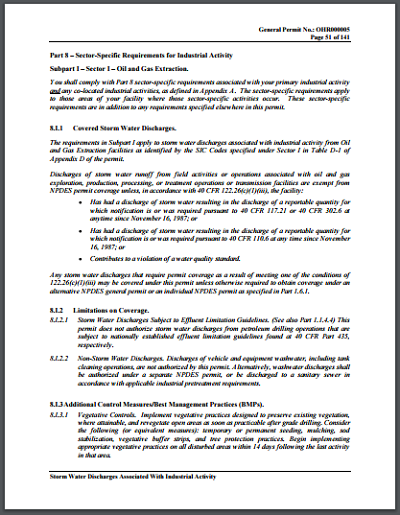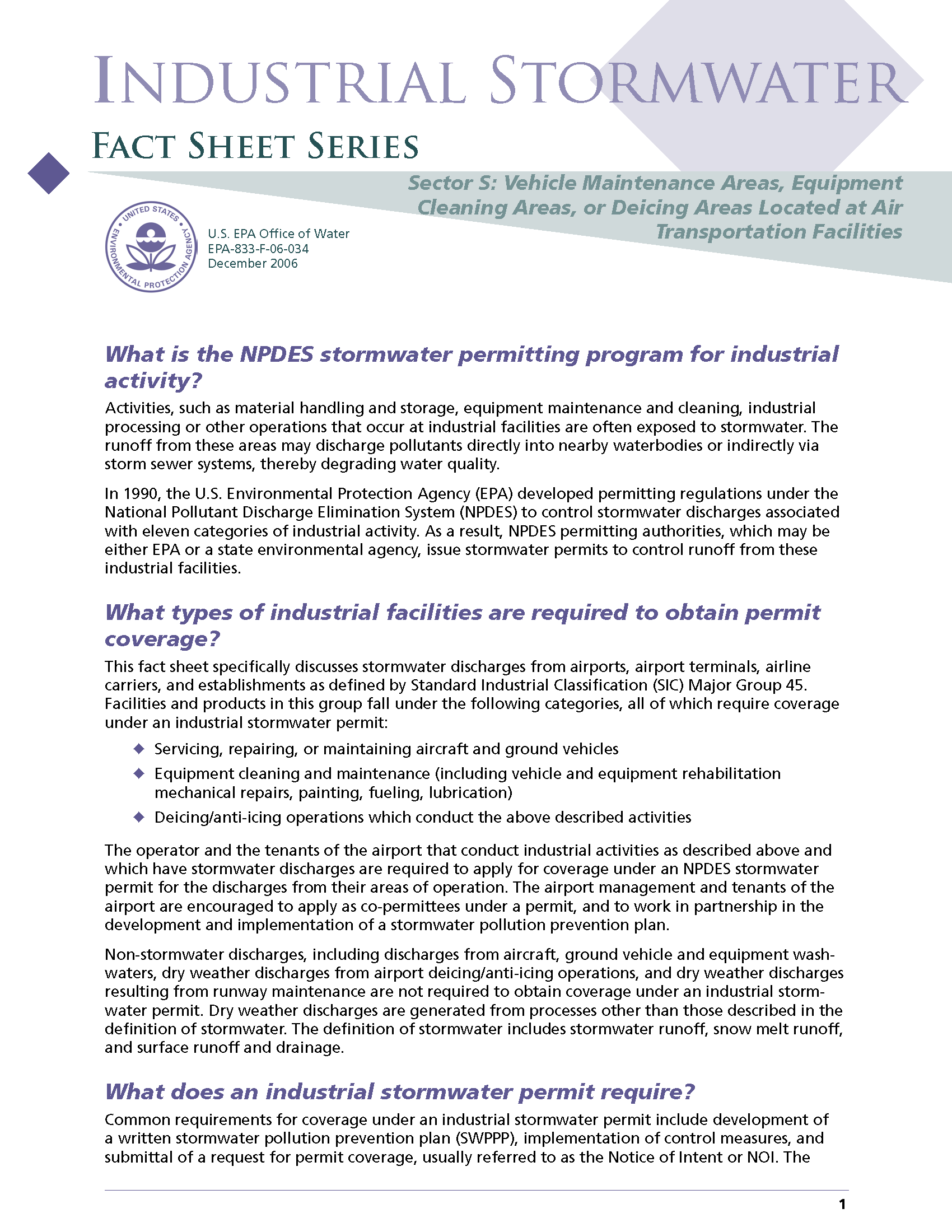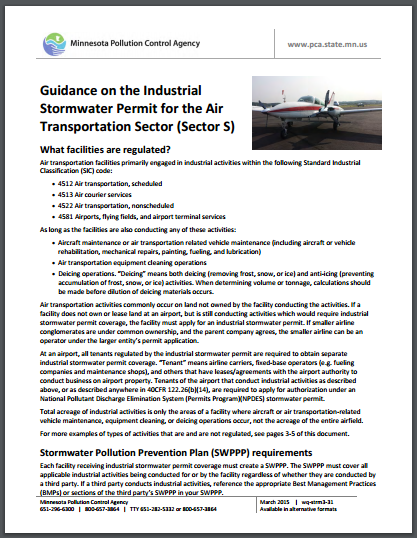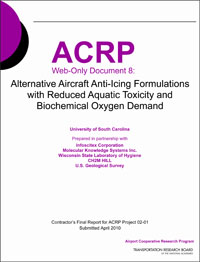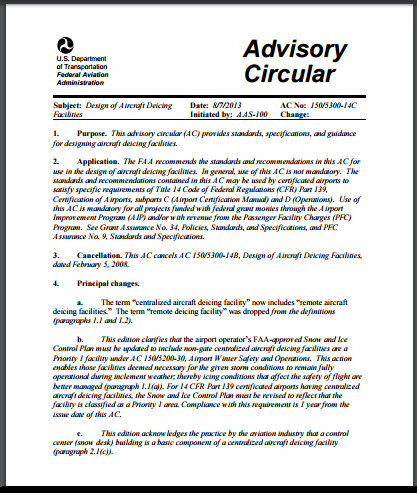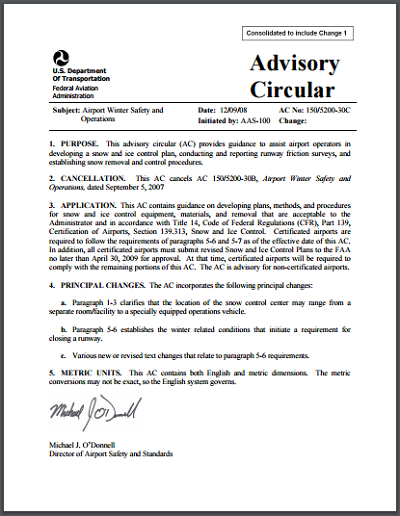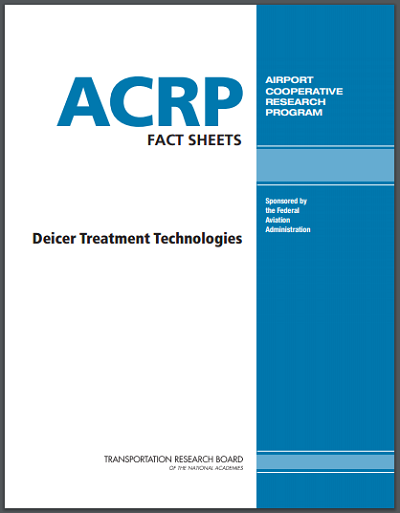< Return to Pollutants & Sources
Monitoring & Sampling

Regular monitoring and sampling of stormwater will help determine the effectiveness of an airport’s stormwater management program and stormwater control measures. An airport’s stormwater management program may include inspections, visual assessments, and sampling of specified stormwater discharges.
Stormwater inspections and visual assessments provide qualitative information on whether there are unaddressed potential pollutant sources at your facility, and whether existing control measures are effective or need to be reevaluated. Visual inspection of stormwater is an inexpensive way of detecting the presence of pollutants that affect the appearance of the discharge.
Stormwater sampling provides quantitative (i.e., numeric) data to determine pollutant concentrations in runoff and, in turn, the degree to which control measures are effectively minimizing contact between stormwater and pollutant sources, and the success of your stormwater control approach in meeting applicable discharge requirements or effluent limits. Key stormwater parameters are most often monitored by collecting water samples from a stormwater discharge and sending the samples to an off-site laboratory for analytical testing. Some stormwater parameters can be monitored in the field, or in situ, using a variety of on-site monitoring methods such as water quality meters and field test kits.
This page identifies resources to use in the planning and implementation of stormwater monitoring programs at airports. Because airports come in many sizes and configurations, monitoring programs must be tailored to the specifics of each facility. Always refer to the specific permit or regulatory requirements applicable to your facility.
ACRP Resources
ACRP Research Report 72: Guidebook for Selecting Methods to Monitor Airport and Aircraft Deicing Materials, Second Edition This guidebook provides tools to identify, compare, and select practical on- and off-site methods for monitoring deicing materials in water.
Webinar – Environmental Planning for Airport Winter Operations This webinar presents the results from three ACRP publications related to airport winter operations, one of which is ACRP Research Report 72: Guidebook for Selecting Methods to Monitor Airport and Aircraft Deicing Materials, Second Edition.
ACRP Report 134: Applying Whole Effluent Toxicity Testing to Aircraft Deicing Runoff This report discusses special considerations to be taken in conducting whole effluent toxicity testing that may be required as part of National Pollutant Discharge Elimination System (NPDES) permit compliance monitoring.
Other Stormwater Resources
EPA 2015 Multi-sector General Permit (MSGP) regulates stormwater discharges associated with specific categories of industrial activity. Many of the requirements, including visual monitoring, apply to all categories. Airport transportation facilities are discussed in Subpart 8S, page 144.
Industrial Stormwater Fact Sheet – Sector S This fact sheet provides additional information and guidance on complying with Sector S specific requirements.
Guidance on the Industrial Stormwater Permit for the Air Transportation Sector (Sector S) This document prepared by the Minnesota Pollution Control Agency provides additional guidance for complying with Sector S requirements of the MSGP.
Guidelines Establishing Test Procedures for the Analysis of Pollutants Under the Clean Water Act; National Primary Drinking Water Regulations; and National Secondary Drinking Water Regulations; Analysis and Sampling Procedures This rule promulgates procedures for the analysis of pollutants for compliance with the Clean Water Act and Primary/Secondary Drinking Water Regulations.
Industrial Stormwater Monitoring and Sampling Guide This guide explains how to conduct visual and analytical monitoring of stormwater discharges. It can be used by facilities required to comply with MSGP’s monitoring requirements as well as facilities subject to other state- or federal-issued industrial stormwater permits.
Caltrans Stormwater Monitoring Program Manual This manual was prepared for the implementation of the Caltrans Stormwater Monitoring Program; however, the guidance on standardized procedures for sample collection, sample analysis, and data reporting are applicable to most stormwater monitoring programs.
Caltrans Construction Site Monitoring Program Guidance Manual This manual was prepared for the implementation of the Caltrans Construction Site Monitoring Program; however, the guidance on standardized procedures for sample collection, sample analysis, and data reporting are applicable to most construction site monitoring programs.
Technical Report for the Florida Statewide Airport Stormwater Study This technical report describes a statewide study of pollutants found in airport stormwater. It includes tables of water quality parameters and test methods, as well as results of storm event samples collected at a wide range of airports.
NCHRP Report 767: Measuring and Removing Dissolved Metals from Stormwater in Highly Urbanized Areas This report summarizes concerns about current methods used to determine dissolved metal content in stormwater, reviews previous studies of the treatment of dissolved metals, and proposes prototype conceptual designs for metals treatment. Appendix A provides practical guidance for measurement of dissolved metals in stormwater runoff.
Clean Water Act National Pollutant Discharge Elimination System Compliance Monitoring Strategy The Compliance Monitoring Strategy provides recommended minimum frequencies for compliance monitoring activities that, from a national perspective, EPA believes constitute a strong and balanced compliance monitoring program that should be reflected in all approved state NPDES and pre-treatment programs, as well as in all EPA direct implementation activities.
Urban Stormwater BMP Performance Monitoring This manual was developed as part of the International Stormwater Best Management Practice (BMP) Database project to provide guidance regarding stormwater BMP monitoring. It presents protocols and standards for collecting, storing, analyzing, and reporting stormwater BMP monitoring data to support understanding of the function, efficiency, and design of urban stormwater BMPs.
Note: All external links were functional at the time this website was published. If a link is broken, use the title of the document to search for an updated link.

